
Microwaves are a form of electromagnetic radiation with wavelengths ranging from about one meter to one millimeter; with frequencies between 300 MHz (1 m) and 300 GHz (1 mm). Different sources define different frequency ranges as microwaves; the above broad definition includes both UHF and EHF bands. A more common definition in radio engineering is the range between 1 and 100 GHz. In all cases, microwaves include the entire SHF band at minimum. Frequencies in the microwave range are often referred to by their IEEE radar band designations: S, C, X, Ku, K, or Ka band, or by similar NATO or EU designations.
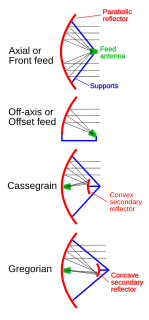
In telecommunications and radar, a Cassegrain antenna is a parabolic antenna in which the feed antenna is mounted at or behind the surface of the concave main parabolic reflector dish and is aimed at a smaller convex secondary reflector suspended in front of the primary reflector. The beam of radio waves from the feed illuminates the secondary reflector, which reflects it back to the main reflector dish, which reflects it forward again to form the desired beam. The Cassegrain design is widely used in parabolic antennas, particularly in large antennas such as those in satellite ground stations, radio telescopes, and communication satellites.
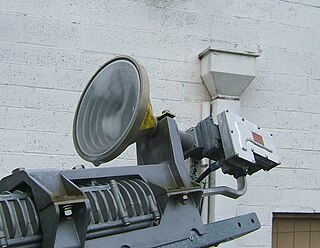
In parabolic antennas such as satellite dishes, a feed horn is a small horn antenna used to convey radio waves between the transmitter and/or receiver and the parabolic reflector. In transmitting antennas, it is connected to the transmitter and converts the radio frequency alternating current from the transmitter to radio waves and feeds them to the rest of the antenna, which focuses them into a beam. In receiving antennas, incoming radio waves are gathered and focused by the antenna's reflector on the feed horn, which converts them to a tiny radio frequency voltage which is amplified by the receiver. Feed horns are used mainly at microwave (SHF) and higher frequencies.

A parabolicreflector is a reflective surface used to collect or project energy such as light, sound, or radio waves. Its shape is part of a circular paraboloid, that is, the surface generated by a parabola revolving around its axis. The parabolic reflector transforms an incoming plane wave traveling along the axis into a spherical wave converging toward the focus. Conversely, a spherical wave generated by a point source placed in the focus is reflected into a plane wave propagating as a collimated beam along the axis.

A parabolic antenna is an antenna that uses a parabolic reflector, a curved surface with the cross-sectional shape of a parabola, to direct the radio waves. The most common form is shaped like a dish and is popularly called a dish antenna or parabolic dish. The main advantage of a parabolic antenna is that it has high directivity. It functions similarly to a searchlight or flashlight reflector to direct the radio waves in a narrow beam, or receive radio waves from one particular direction only. Parabolic antennas have some of the highest gains, meaning that they can produce the narrowest beamwidths, of any antenna type. In order to achieve narrow beamwidths, the parabolic reflector must be much larger than the wavelength of the radio waves used, so parabolic antennas are used in the high frequency part of the radio spectrum, at UHF and microwave (SHF) frequencies, at which the wavelengths are small enough that conveniently-sized reflectors can be used.

A directional antenna or beam antenna is an antenna which radiates or receives greater power in specific directions allowing increased performance and reduced interference from unwanted sources. Directional antennas provide increased performance over dipole antennas—or omnidirectional antennas in general—when greater concentration of radiation in a certain direction is desired.
Super high frequency (SHF) is the ITU designation for radio frequencies (RF) in the range between 3 and 30 gigahertz (GHz). This band of frequencies is also known as the centimetre band or centimetre wave as the wavelengths range from one to ten centimetres. These frequencies fall within the microwave band, so radio waves with these frequencies are called microwaves. The small wavelength of microwaves allows them to be directed in narrow beams by aperture antennas such as parabolic dishes and horn antennas, so they are used for point-to-point communication and data links and for radar. This frequency range is used for most radar transmitters, wireless LANs, satellite communication, microwave radio relay links, and numerous short range terrestrial data links. They are also used for heating in industrial microwave heating, medical diathermy, microwave hyperthermy to treat cancer, and to cook food in microwave ovens.

A horn antenna or microwave horn is an antenna that consists of a flaring metal waveguide shaped like a horn to direct radio waves in a beam. Horns are widely used as antennas at UHF and microwave frequencies, above 300 MHz. They are used as feed antennas for larger antenna structures such as parabolic antennas, as standard calibration antennas to measure the gain of other antennas, and as directive antennas for such devices as radar guns, automatic door openers, and microwave radiometers. Their advantages are moderate directivity, low standing wave ratio (SWR), broad bandwidth, and simple construction and adjustment.

A microwave antenna is a physical transmission device used to broadcast microwave transmissions between two or more locations. In addition to broadcasting, antennas are also used in radar, radio astronomy and electronic warfare.

An antenna reflector is a device that reflects electromagnetic waves. Antenna reflectors can exist as a standalone device for redirecting radio frequency (RF) energy, or can be integrated as part of an antenna assembly.
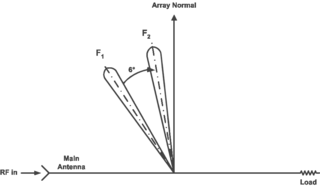
In a phased array or slotted waveguide antenna, squint refers to the angle that the transmission is offset from the normal of the plane of the antenna. In simple terms, it is the change in the beam direction as a function of operating frequency, polarization, or orientation. It is an important phenomenon that can limit the bandwidth in phased array antenna systems.

Conical scanning is a system used in early radar units to improve their accuracy, as well as making it easier to steer the antenna properly to point at a target. Conical scanning is similar in concept to the earlier lobe switching concept used on some of the earliest radars, and many examples of lobe switching sets were modified in the field to conical scanning during World War II, notably the German Würzburg radar. Antenna guidance can be made entirely automatic, as in the American SCR-584. Potential failure modes and susceptibility to deception jamming led to the replacement of conical scan systems with monopulse radar sets. They are still used by the Deep Space Network for maintaining communications links to space probes. The spin-stabilized Pioneer 10 and Pioneer 11 probes used onboard conical scanning maneuvers to track Earth in its orbit.
Monopulse radar is a radar system that uses additional encoding of the radio signal to provide accurate directional information. The name refers to its ability to extract range and direction from a single signal pulse.
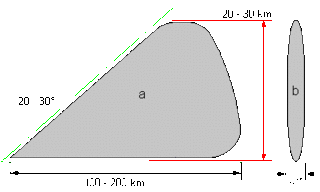
A fan-beam antenna is a directional antenna producing a main beam having a narrow beamwidth in one dimension and a wider beamwidth in the other dimension. This pattern will be achieved by a truncated paraboloid reflector or a circular paraboloid reflector. Since the reflector is narrow in the vertical plane and wide in the horizontal, it produces a beam that is wide in the vertical plane and narrow in the horizontal.

Metamaterial antennas are a class of antennas which use metamaterials to increase performance of miniaturized antenna systems. Their purpose, as with any electromagnetic antenna, is to launch energy into free space. However, this class of antenna incorporates metamaterials, which are materials engineered with novel, often microscopic, structures to produce unusual physical properties. Antenna designs incorporating metamaterials can step-up the antenna's radiated power.
Microwave engineering pertains to the study and design of microwave circuits, components, and systems. Fundamental principles are applied to analysis, design and measurement techniques in this field. The short wavelengths involved distinguish this discipline from Electronic engineering. This is because there are different interactions with circuits, transmissions and propagation characteristics at microwave frequencies.

The Foster scanner, or Variable Path scanner, is a type of radar system that produces a narrow beam that rapidly scans an area in front of it. Foster scanners were widely used in post-World War II radar systems used for artillery and mortar spotting. Modern radars in this role normally use electronic scanning in place of a Foster scanner for this purpose.
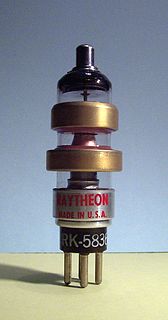
A Sutton tube, or reflex klystron, is a type of vacuum tube used to generate microwaves. It is a low-power device used primarily for two purposes; one is to provide a tuneable low-power frequency source for the local oscillators in receiver circuits, and the other, with minor modifications, as a switch that could turn on and off another microwave source. The second use, sometimes known as a soft Sutton tube or rhumbatron switch, was a key component in the development of microwave radar during World War II. Microwave switches of all designs, including these, are more generally known as T/R tubes or T/R cells.
Ernest Wilmot Guptill was a Canadian physicist. He spent his academic career at Dalhousie University, where he was department head for ten years. He was co-inventor of the slotted waveguide antenna.
In radio systems, many different antenna types are used with specialized properties for particular applications. Antennas can be classified in various ways. The list below groups together antennas under common operating principles, following the way antennas are classified in many engineering textbooks.




















